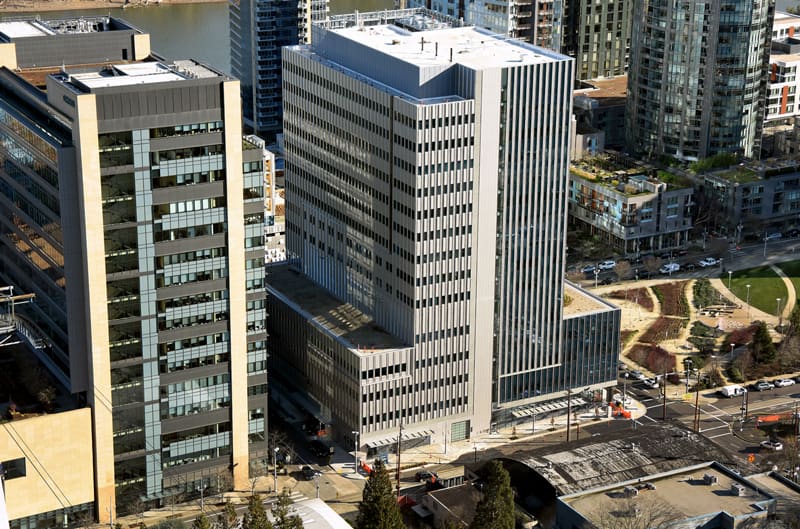ECC is using Alerton’s BACnet building automation system to control and monitor all aspects of the buildings’ thermal comfort. Temperature in the building is measured and trended to verify occupant comfort. Working in association with the design engineer and balancing agent, ECC developed outside air flow curves for all of the main Air Handling Units. An advanced algorithm is used to determine the real-time position of each main air handling unit’s outside air flow compared to the actual fan capacity. The data is then trended and used to calculate the required damper position for maintaining the outdoor air ventilation set point. Heat recovery coils are used in the main air handlers to allow for increased ventilation during both extremely cold and hot days.
A thermal storage system consists of 4-Thermal Storage Tanks, one of which provides reheat to the domestic hot water system, 3-swimming pools, 3-radiant slab zones on the ground floor, and 1-heat recovery/water reclamation tank. The swimming pools are integrated with the heating and cooling system as a thermal storage unit.
Waste heat is generated by a gas-fueled cogeneration system powered by five 60-kilowatt microturbines. A heat exchanger is tied into the condenser loop of the Process Cooling Chiller to allow for further heat recovery when the main chillers are not in operation.
Heat contained in the main exhaust air from the two Research Lab Floors is recovered using 2 Air-to-Water Heat Exchanger Coils located on the roof. This recovered heat is then used to preheat the makeup air entering the Research Labs.
The south-side of the building on the 15th and 16th floors was transformed into a giant solar air heater by creating a 6,000 square foot trombe wall consisting of two glass skins. The warm air produced inside the trombe wall by the greenhouse effect is recirculated through the building in winter reducing the building’s energy use.
Both the Thermal Storage and Heat Recovery systems are integrated together and controlled by the Alerton BAS, to keep the building operating at maximum energy efficiency.
Chilled beams combine convective cooling systems with displacement ventilation, which reduce energy use by twenty to thirty percent compared to conventional air conditioning systems and reduces the need for ductwork and other mechanical systems.
The building includes a 100% rainwater reclamation system that harvests rainwater and wastewater for landscaping. Potable water use is reduced by 56% and no potable water is used for waste conveyance or irrigation in the building. ECC controls and monitors the rainwater reclamation system, which saves thousands of gallons of water each day from ever reaching the city’s sewer system. Additionally, there is a wastewater treatment facility inside the building. This system works in parallel with the water reclamation system and is monitored and alarmed by ECC. All of the wastewater generated by the building is processed through this system. The processed clean effluent water is then stored in a large tank and can be used as non-potable water backup for times when the rainwater and groundwater sources are not available.
Integration was a key aspect of the project. With so many complex systems needing to work together, it was imperative to use a controls contractor with extensive systems integration experience. By using industry standard protocols, this high level of integration was achieved cost effectively. OHSU is using BACnet as the foundation protocol for integration.
For example, all of the main lighting controls are integrated into the Alerton system using MODBUS to BACnet, allowing building operators to use a common interface and set of tools for scheduling HVAC and lighting.
By integrating the 6 Fulton Boilers to BACnet, ECC is able to enable and disable the boilers and provide them with the loop temperature setpoint, as well as monitor all of the boiler functions and alarms. To maintain this many points and alarms using a conventional input/output method would have been cost prohibited.
The 22 native BACnet ABB VFDs are integrated into the same MS/TP network as the field controllers. Installation costs were reduced by only having to run a single network for all devices.
Another important part of ECC’s involvement in the project was assisting the commissioning agent in development of the commissioning forms, as well as assisting in the commissioning process. Working with the design engineer and commissioning agent, ECC developed control strategies that will optimize building system performance while using a minimum amount of electrical power and natural gas.
Trend logs and energy logs were set up for every measured point in the building to verify system operation. ECC engineers were available to provide support as requested enabling the commissioning agent to perform all enhanced commissioning activities.
OHSU Center for Health and Healing represents the state-of-the-art in integrated green design as well as being a cost effective project. Both the mechanical and electrical systems came in under the $30 million allotted for a standard design.



